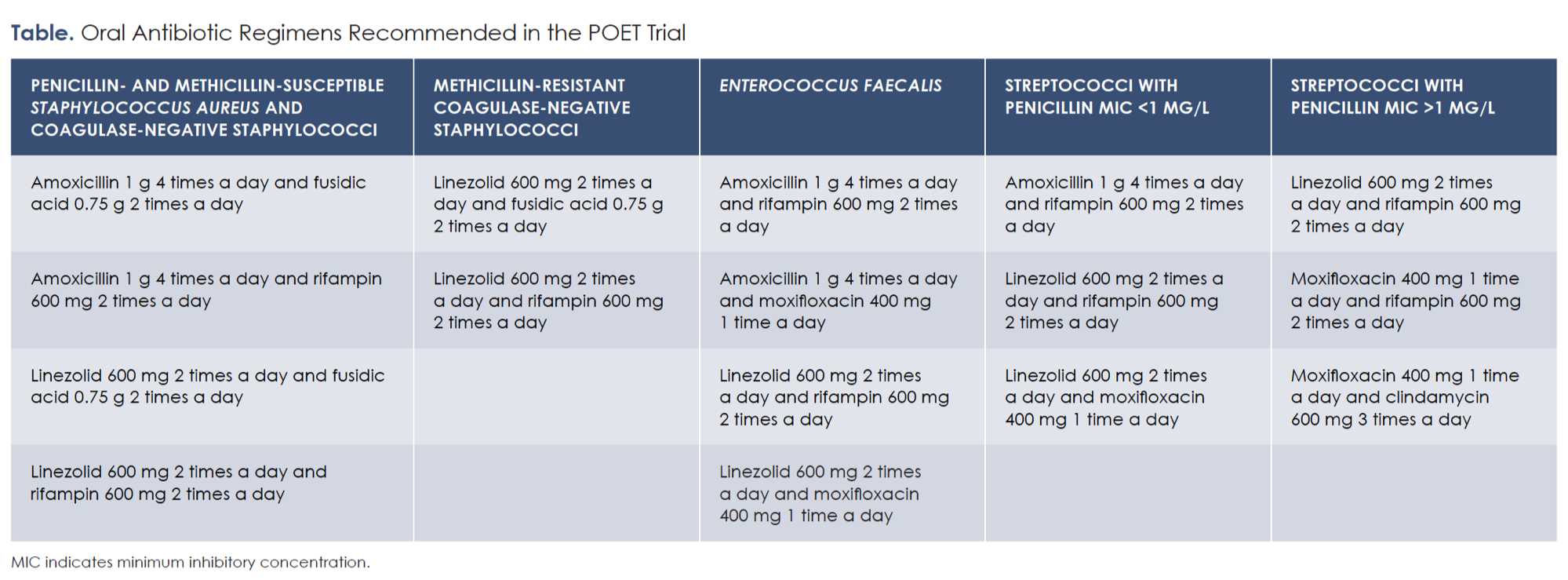Partial Oral Treatment of Infective Endocarditis Can Be Effective in Select Patients: Review of the POET Trial
By itself, the POET trial should not fundamentally change the current approach to infective endocarditis treatment.
The opioid crisis has altered the epidemiology of infective endocarditis dramatically in recent years, with the condition now affecting more young patients identified as persons who inject drugs (PWID).1,2 Traditionally, treatment for infective endocarditis in the United States has adhered to the American Heart Association’s 2015 guidelines, which recommend up to 6 weeks of intravenous (IV) antibiotics.3 Although older literature suggested oral therapy was effective for right-sided Staphylococcus aureus infective endocarditis,4 such an approach is not currently standard. Thus, most patients with infective endocarditis will be on long-term IV antibiotics and face the associated risks and costs of indwelling catheters and home infusion or prolonged hospitalization. With the shifting demographic of infective endocarditis toward PWID—generally poor candidates for outpatient IV therapy—the need for research assessing outcomes with oral treatment has never been greater.
The Partial Oral Treatment of Endocarditis (POET) trial,5 conducted in Denmark, is a much-needed addition to the endocarditis literature. The authors performed a noninferiority comparative trial between patients with infective endocarditis treated with IV therapy (control arm) with those switched to oral therapy after an initial IV course (experimental arm). Eligible patients were 18 years or older, in stable condition, already on IV antibiotics, had left-sided infective endocarditis with streptococci species, Enterococcus faecalis, S aureus, or coagulase-negative staphylococci species, and no absolute indications for valve replacement. IV antibiotic choice was in accordance with European Society of Cardiology guidelines.6 Oral regimens consisted of 2 antibiotics from different drug classes, guided by bioavailability and minimum inhibitory concentration (MIC) data (Table). The primary composite outcome was all-cause mortality, unplanned cardiac surgery, clinically evident embolic events, or relapse of bacteremia with the primary pathogen within 6 months.

Click the table to view a larger version.
From 2011 to 2017, 400 patients were enrolled and randomized. Mean age was 67 years, 77% of participants were men, 22 (6%) had prosthetic valve endocarditis, 152 (38%) had valve replacement prior to randomization, and 35 (9%) had implanted cardiac devices. Only 5 (1.2%) participants were identified as PWID, and 0 patients had methicillin-resistant S aureus (MRSA). Patients in the experimental arm received a median 17 days of IV antibiotics prior to oral transition.
The primary outcome occurred in 24 (12.1%) patients in the IV group and 18 (9.0%) in the oral group; thus, the criterion for noninferiority was met, with no significant differences in adverse events between arms.
For patients with infective endocarditis who meet the POET inclusion criteria, oral step-down therapy appears to be noninferior to the traditional “all-IV” pathway. It is important to keep in mind patient-specific issues that may interfere with oral drug absorption.7 Notably, the POET trial was lacking in key populations: The data represent no patients with MRSA and only 5 PWID. Therefore, it is uncertain whether the POET trial is the answer to the dilemma of an increase in PWID with infective endocarditis who require long hospitalizations to complete IV antibiotic courses.
By itself, the POET trial should not fundamentally change the current approach to infective endocarditis treatment. However, as more data emerge, treatment guidelines will evolve and may one day support a less resource-intensive but equally efficacious approach for these patients. For now, POET reassures us that for patients doing well on standard therapy who are poor candidates to continue IV treatment, step-down to oral therapy is a reasonable choice.
References
- Wurcel AG, Anderson JE, Chui KKH, et al. Increasing infectious endocarditis admissions among young people who inject drugs. Open Forum Infect Dis. 2016;3(3):ofw157. doi: 10.1093/ofid/ofw157.
- Thakarar K. Infectious Endocarditis and morbidity: epidemiological patterns in the setting of the opioid epidemic. Poster presentation at: IDWeek; October 28, 2016; New Orleans. Available at: https://idsa.confex.com/idsa/2016/webprogram/Paper59580.html. Accessed September 12, 2018.
- Baddour LM, Wilson WR, Bayer AS, et al. Infective endocarditis in adults: diagnosis, antimicrobial therapy, and management of complications: a scientific statement for healthcare professionals from the American Heart Association. Circulation. Circulation. 2015;132(15):1435-1486. doi: 10.1161/CIR.0000000000000296.
- Dworkin RJ, Lee BL, Sande MA, Chambers HF. Treatment of right-sided Staphylococcus aureus endocarditis in intravenous drug users with ciprofloxacin and rifampicin. Lancet. 1989;2(8671):1071-1073.
- Iversen K, Ihlemann N, Gill SU, et al. Partial oral versus intravenous antibiotic treatment of endocarditis [published online August 28, 2018]. N Engl J Med. doi: 10.1056/NEJMoa1808312.
- Habib G, Lancellotti P, Antunes MJ, et al. 2015 ESC guidelines for the management of infective endocarditis: the Task Force for the Management of Infective Endocarditis of the European Society of Cardiology (ESC). Endorsed by: European Association for Cardio-Thoracic Surgery (EACTS), the European Association of Nuclear Medicine (EANM). Eur Heart J. 2015;36(44):3075-3128. doi: 10.1093/eurheartj/ehv319.
- Hale AJ, Snyder GM, Ahern JW, Eliopoulos G, Ricotta D, Alston WK. When are oral antibiotics a safe and effective choice for bacterial bloodstream infections? An evidence-based narrative review. J Hosp Med. 2018;13(5):328-335. doi: 10.12788/jhm.2949.
